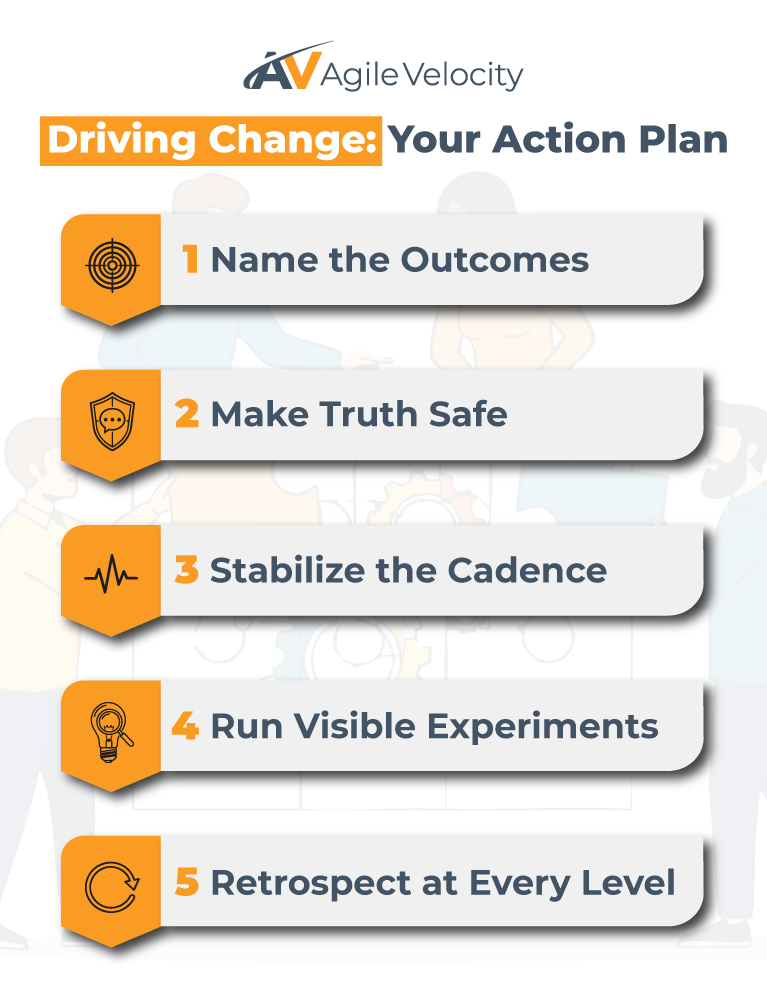By Bhavani Krishnan, Enterprise Business Agility Consultant at Agile Velocity
Co-hosted with Gina Foster, Senior Director of Client Success at Agile Velocity
The room was already humming when Gina and I took our seats at the front of zoom cameras. Not the kind of buzz you get from slide decks and status updates—the human kind. Curiosity. A little skepticism. Hope.
“Today isn’t about new tools for the sake of tools,” I began. “It’s about how leaders create real, sustainable change—how we think, how we work, and how we lead together.”
Gina smiled and picked up the thread. “And we’re thrilled,” she said, “because our panelists are incredible leaders, each with a unique perspective on driving organizational change.” She introduced Bala Vinayagam (President, Qualitrol), Cindi Schulenberg (Director of UX Research & Design, Southwest Airlines), and Jeff Terrell (Program & Transformation Leader, formerly Expedia/HomeAway/Zen Business). The discussion that followed was a masterclass in leadership, and you can watch the full webinar recording to see the entire conversation unfold.
When Mindset Walks Into The Room
We started with the heartbeat check. “Why does this topic matter to you personally?”” Gina asked each panelist. What came next was incredible!!
Bala didn’t miss a beat. “Agility is a cornerstone for innovation”, he said. “But it only works when people embrace the change that comes with it”.
Cindi being the huge advocate for Lean principles, framed it simply: “Things can’t stay the same and improve.” For her, continuous improvement isn’t a capability, it’s a discipline.
Jeff nodded adding, “ Change is constant. The real question is whether leaders help their people through it”.
In that first few minutes, the theme landed: Change is Cultural before it’s Procedural.
The Pivot from Control to Conditions
Gina and I wanted to press on the importance of empowering people in any condition. We invited Cindi to take us inside the modern executive role. It was refreshing to hear an executive who didn’t focus on statuses and dashboards. She talked about conditions – Psychological safety, a clear vision, actionable success criteria, and the courage to remove the organizational barriers that slow innovation.
“Executives are shifting from directing to enabling empowered, cross-functional teams,” she said. “You can’t control your way of learning”.
Along the same lines, Bala added the cautionary tale many of us know too well: Organizations try to scale processes faster than they scale principles. “ You can’t scale innovation through control,” he said. “Give teams the what and the why. Trust them with the how. And give them the data – because empowerment without information is just guesswork”. That statement made Gina and I jump for joy internally. It took us back to one of the Agile Principles – ‘Build projects around motivated individuals. Give them the environment and support they need and trust them to get the job done’.
Balancing Cadence and Change
Ok, so we had the mindset and the conditions, but what about the balance to test it? Gina and I are both grounded on validation. I asked how the panelists balance operational excellence with experimentation. Cindi’s answer was both grounded and generous: Create a disciplined foundation – lightweight governance, clear metrics, consistent delivery – so that test-and-learn has a safe home. Experimentation doesn’t compete with planned work; it feeds it.
She followed that up with a real work experience (for the skeptics like Gina and I). Years ago, Southwest Airlines faced a highly visible challenge with baggage. Rather than mount a years-long monolith, cross-functional teams worked together, prioritized high value work and delivered a Bag Tracker within the same year. Smaller chunks, shipped steadily, aimed at a problem customers faced. We all nodded; visible progress is belief’s best friend.
While Cindy talked about team autonomy resulting in accelerated delivery, Jeff provided a different perspective but a significant one. “I watched a company change its portfolio planning cycle three times in nine months,” he said. “Too much change, too fast, and no one can improve inside the system.” It dawned on me, in shouty capitals….CADENCE CREATES THE SPACE WHERE IMPROVEMENT HAPPENS!!!
Winning Hearts Before Plans
“Where does resistance really come from?” I asked Bala and without hesitation he said “Experience, not attitude”. People have seen transformation arrive with fanfare and disappear six months later. He added, skepticism is earned which is so true!!
Bala’s remedy to this starts with listening – really listening – to what sits under the resistance: fatigue, fear, unclear intent. Then connect the change to something meaningful: a customer story, a tangible business opportunity, or a personal win. Make early wins visible, even if it is small. Nothing influences minds like success that is visible.
The Middle Is the Medium
What followed was a reality Gina and I both see often: executives sponsor change, frontline teams are hopeful – but middle management carries the heaviest load, asked to deliver and transform at once.
For this Jeff offered practical advice from his playbook: include managers early, set up continuous feedback loops (1:1s, Lean Coffees), co-design local adaptations while aligning on a small set of outcome metrics that matter – quality, time-to-market, customer impact etc. After all one size won’t fit all; and alignment on outcomes makes flexibility safe and efficient.
Scaling Without Losing The Plot

We learned that Bala has scars from integrating engineering acquisitions. The lesson he shared with us – Codify the principles behind what worked – behaviors, mindsets, structures – before you scale mechanics. Don’t copy/paste the Spotify model if you are building nuclear-grade hardware. Keep a shared north star through outcomes, values, and metrics; allow local autonomy in execution.
When empowerment is real, it might be boring on paper but electric in practice: clear decision rights, access to context, leaders who model curiosity and vulnerability. It shows up as engagement – people leaning toward the problem, not away from it.
Rapid Signals, Real Habits
Like always, all good things must come to an end. Although we were having rich discussions and learning we were running out of time. We closed with a rapid-fire round that felt more like a shared manifesto:
- One word for great leadership? Intentional. Clarity. Transparent
- Grounding practices? Reflection. Journaling. Listening
- Myths to get rid of? Transformation is NOT a step change; it’s an incremental grind with no fixed endpoint. And change isn’t “hard” – its new
One thread that is engrained in our minds from all this discussion – Connect quarterly pressures to the longer arc. Help teams see the thread from today’s deliverables to tomorrow’s transformation. Momentum is not a moment; it’s a system of habits.
What you can do tomorrow
Gina and I gathered from the leaders a list of things that you can try
- Name the outcomes – two or three business outcomes that matter
- Make truth safe – create forums where risk and dissent surface early – and reward candor
- Stabilize the cadence – hold the operating model steady, long enough to improve inside it
- Run visible experiments – tie test-and-learn to planned work; showcase learning and impact
- Retrospect at every level – teams, managers, executives – at a regular cadence without fail
As we wrapped up Bala offered one last word to describe how teams respond when leaders walk the talk: BELIEF!!!
Gina, I and the other panelists acknowledged in unison. A shift you can’t fake. The kind that turns transformation from a project into a practice
Mindset first. Conditions over control. Trust before templates. That’s how meaningful change moves from slide to system – and stays.
Inspired by this conversation? This article captures just a few of the powerful insights from the panel. To hear all the stories and advice directly from Bala, Cindi, and Jeff, watch the complete on-demand webinar now.





